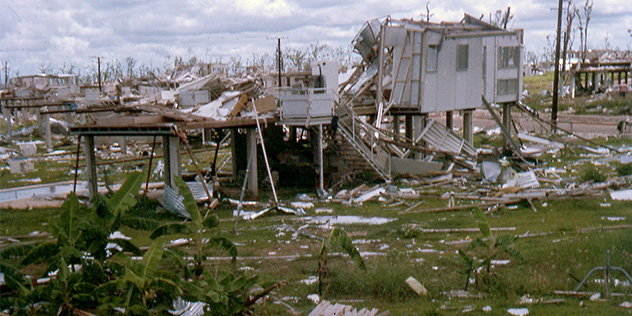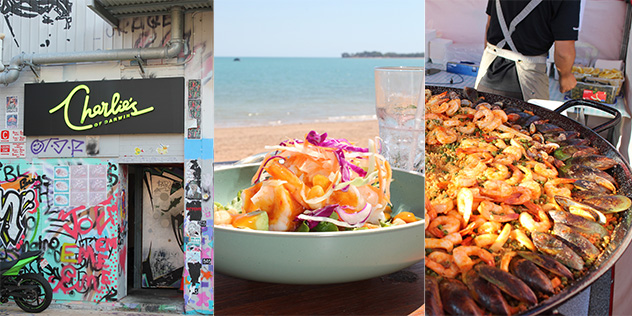Tropical homecoming

I’d have been named Tracy, were it not for the cyclone that decimated Darwin, uplifting cars, twisting steel power poles, shredding homes and extinguishing lives in the early hours of Christmas Day 1974.
My parents were just a few months pregnant with me when their home, in the northern suburbs of the city, became one of the many obliterated in the ferocious onslaught of Cyclone Tracy.
After the roof blew off their stilted house, causing the walls to implode, they were forced downward – sliding beneath a bathtub blown across their outdoor staircase – to seek shelter in a ground-level storage room.
They huddled there, buckets over their heads and a metal rubbish bin lid for protection, as the floorboards above them peeled away. When they finally emerged, their lives, those around them, and my intended name had all been altered irrevocably.

Looking from my parents yard after Cyclone Tracy
It’s a thought not lost on me as my midnight flight touches down on the same tarmac from which my mother was evacuated by Hercules aircraft almost a half-century earlier. This Christmas marks the 50th anniversary of Cyclone Tracy, so for me this visit is commemorative and tinged with an added dose of sentimentality.
We returned to live in Darwin when I was teenager. Even in my current bleary-eyed state, its wide roads are familiar and I find my way effortlessly to the iconic tri-arced edifice on the city’s Esplanade.
At the time of Tracy, this newly-completed high-rise – then the Travelodge Hotel – dominated Darwin’s skyline and photos of cars thrust into its swimming pool by the cyclone’s intensity were splashed across the pages of national press.
The hotel was damaged but emerged comparatively unscathed and became a hub for many who assisted with the recovery effort.
Today, following an extensive 2023 refurbishment and relaunch as the Hilton Garden Inn, the upmarket hotel offers me a modern, airy welcome to the Top End. The only things left to hint at its early years are its curvaceous form, a few panels of breeze blocks popular in the 1970s, and the shape of the outdoor pool.
In my deluxe harbour-view room, the comfort of the king-size bed beckons first and foremost, but the next morning I’m immediately grateful for the niceties that surround me. The décor is elevated yet understated, deliberately I suspect, to emphasise the expanse of vibrant blue sky and sapphire ocean that stretches beyond the juliet balcony.
Clutching a coffee, I step outside to admire the 180-degree panorama and am immediately reminded of the need to get moving – it’s not even 8am and already the temperature has risen to 24ºC. Activity in this region of Australia is best planned for the early and latter hours, with a midday retreat to air conditioning all but mandated, so I set out for the George Brown Darwin Botanic Gardens.
A lush collection of tropical plants – palms, cycads, frangipani and boab – occupy the 42-hectare green space and it’s difficult to imagine it stripped of leaves, destroyed by Tracy’s winds, which clocked 217km/h before the measuring equipment failed.
Ten majestic rain trees (Albizia saman) were found toppled among the carnage, and I pause to admire one that was salvaged. A treehouse has been built around its base and I linger in its shade, listening to the laughter of children playing until my stomach convinces me to backtrack to Eva’s Botanic Garden Café.
Housed in a former 19th century church, one of the Territory’s oldest buildings, the café befits my nostalgia and a laksa eggs benedict – its hollandaise infused with the Malaysian spice and coconut flavour embraced as a Darwin staple – proves the ideal homecoming breakfast.
I walk it off at nearby East Point Reserve, a recreational haven for locals and site of historic military defences. It’s also where Cyclone Tracy is believed to have made landfall and survivors plan to have a memorial. Then, just south at the Museum and Art Gallery of the Northern Territory (MAGNT), I retreat to the air conditioning within its permanent Cyclone Tracy exhibition, which is undergoing a revamp to honour the 50th anniversary.

Mindil Beach at sunset
My parents and other survivors still speak about the howling roar of wind, airborne sheet metal and thrashing rain that the sound booth here replicates and museum curator, Jared Archibald, assures me will remain a focus of the upgrade.
The updated exhibition opens on December 7 and features a replica 1970s house, an interactive Bureau of Meteorology office fitted with the actual radar used to monitor Tracy, and a complete refresh of visual displays.
“The redevelopment balances retaining many of the elements that have made the exhibition so popular with some powerful, new exhibits,” says Jared, adding that he and his team are mindful of remaining highly sensitive to how devastating this event was, and continues to be, for survivors.
“Cyclone Tracy was a defining event for Darwin. Sixty-six people died and over 80 per cent of housing was destroyed or severely damaged. The old Darwin never returned; a new Darwin grew from the scrap heaps.”
Outside, I reflect on his words as I take in the Timor Sea stretching beyond Bundilla Beach, where the City of Darwin is installing a kinetic sculpture to commemorate the five decades since impact.
After a swim and a rest at my hotel, I return at twilight to reunite with school friends, Jodie and Jason, and their respective families, at Mindil Beach Sunset Market.
It’s a sensory snapshot of the international and indigenous cultures that intermingle in this most northern capital, and a jumble of multi-ethnic eats, tourist wares and live music.
We join the crowds in a customary pilgrimage to the beach to watch and applaud the sun’s kaleidoscopic withdrawal, then tuck into the Sri Lankan curry, Greek souvlaki, Spanish paella and Vietnamese banh mi that converge on our picnic blanket.
Next morning I’m up early to meet Robin MacGillivray of Walk Darwin who guides me and four others on a heritage tour that spans centuries-old tales of the Larrakia people – traditional owners of the region – through to government buildings of the present day.

The Walk Darwin Heritage Tour takes in centuries of Darwin history
Along the way Robin points out a battered metal star on display in Smith Street Mall’s Star Village arcade as a remnant of The Star Picture Theatre, which screened its last movie that fateful Christmas Eve.
There are also the partially rebuilt ruins of the Old Palmerston Town Hall, which survived the WWII bombing of Darwin only to be left a tumble of stones by Cyclone Tracy’s fury.
Afterwards, I pay my respects at a plaque outside the Civic Centre naming those lost in Tracy, then meet my friend Michael for lunch at Darwin Trailer Boat Club. Established in 1958, it’s the city’s oldest seaside club and suffered smashed windows, roof damage and sand inundation due to the cyclone, but bounced back to become a meeting point for many involved in the restoration.
Today its beachside Blue Water Bistro serves a cosmopolitan cast of tourists and locals. We catch up over a fragrant salad of local banana prawns with macadamia, mango and a chilli-lime dressing, and an oversized Territory-caught barramundi burger.
Darwinites take their seafood seriously and the buzzing lunchtime crowd is a testament to the quality here. Given the palm-leaf-framed water vista, ample shade and cooling sea breeze, I’m tempted not to leave, but there’s just enough time for another swim before meeting my friend Kylie that evening.
She assures me the city has become trendy, and as we enter Charlie’s of Darwin via a hidden door on street-art-adorned Austin Lane, I find myself believing her.
In the ambient light, leather chesterfield lounges are silhouetted against the backdrop of a working gin distillery, and outside an alfresco terrace is aglow with lanterns. The cocktail menu lists everything from Guatemalan rum to French champagne.
It seems only polite to partake of the house-made specialty – sublime Kakadu plum, native lemongrass and water lily imbued Darwin Gin – before settling in with duck breast bao buns, slow-cooked pomegranate lamb ribs and charred snake beans tossed with walnuts. It’s all flavourful, fresh and undeniably astounding.
My surprise follows me outside where, in the cool of night, the city has come alive with fairy-lit alfresco dining and small bars overflowing onto footpaths. Colossal murals impart their vitality on otherwise utilitarian walls and there’s an upbeat energy that I don’t quite recognise.

The sights and delights of Darwin
It dawns on me over a nightcap at Flick’s bar, a breezy open-air venue recently unveiled within the old cinema complex (the entertainment mecca of my teenage years), that a gradual evolution has transpired and a ‘new Darwin’ surrounds me.
I note the same vibrancy, amid the raw vegan treats and hawker-style eats, when I pop in for a laksa fix at Parap Village Markets the next morning. The upbeat vibe continues at the Waterfront precinct where a croc-free saltwater swimming beach, wave lagoon, bustling brunch spots, laidback bars and fine dining restaurants coalesce to the soundtrack of live music.
Post Tracy, it took just over three years to rebuild this resilient city and I’ve witnessed it grow and evolve ever since. I’m elated to discover Darwin has not only repaired and revived itself after 50 years, but is now utterly thriving.






